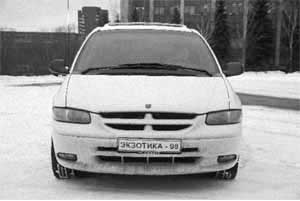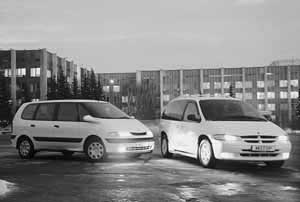Test drive by Renault Espace 1997 - 2002 Minivan
Two mini-wen, two lifestyle
 The word mini-wen was invented by the Americans. However, like the class of second cars, which is indicated by this word. In our country, both Vanya and mini-wen were called without undertaking: minibuses. And if for Van with their rectangular-fabric forms this name was at least somehow appropriate, then for mini-wen it did not suit categorically. However, until a certain point, this did not bother anyone. And only after the appearance of the latter on Russian roads, it became clear to everyone that it was precisely mini-wen, and not minibuses at all.
The word mini-wen was invented by the Americans. However, like the class of second cars, which is indicated by this word. In our country, both Vanya and mini-wen were called without undertaking: minibuses. And if for Van with their rectangular-fabric forms this name was at least somehow appropriate, then for mini-wen it did not suit categorically. However, until a certain point, this did not bother anyone. And only after the appearance of the latter on Russian roads, it became clear to everyone that it was precisely mini-wen, and not minibuses at all.  The first mini-wen appeared relatively recently, only one and a half years ago. The areas of their application are from a family second mobile to the office on wheels. The idea of \u200b\u200bcreating such a machine arose back in 1974 with Ford designers. The car was supposed to meet the three main requirements: a small height of the footboard convenient for women in skirts; a limited height of the roof, which would allow the use of a standard garage; A slightly elongated nose with the engine located in it is protection in case of an accident. Henry Ford did not approve of the project, and the first mini-van left in 1983 from the gate of CHRISLER Corporation. It was the Voyager model (Caravan in the Dodge branch).
The first mini-wen appeared relatively recently, only one and a half years ago. The areas of their application are from a family second mobile to the office on wheels. The idea of \u200b\u200bcreating such a machine arose back in 1974 with Ford designers. The car was supposed to meet the three main requirements: a small height of the footboard convenient for women in skirts; a limited height of the roof, which would allow the use of a standard garage; A slightly elongated nose with the engine located in it is protection in case of an accident. Henry Ford did not approve of the project, and the first mini-van left in 1983 from the gate of CHRISLER Corporation. It was the Voyager model (Caravan in the Dodge branch).  A year later, a similar car called Espace launched the Renault company to the market. Both models are still available. Naturally, they were repeatedly updated. We get acquainted with modern versions of Dodge Caravan and Renault Espace. Their external similarity and the identity of the layout are obvious.
A year later, a similar car called Espace launched the Renault company to the market. Both models are still available. Naturally, they were repeatedly updated. We get acquainted with modern versions of Dodge Caravan and Renault Espace. Their external similarity and the identity of the layout are obvious. Differences concern mainly internal design. And if Espace is interesting primarily by the new designer finds, then the main thing in Caravan is a care for a person. The foregoing does not mean at all that the French mini-wen is inconvenient in operation. Nothing like this. Just in inventing cute little things, the totality of which creates a magnificent atmosphere of comprehensive comfort, Americans are beyond competition. At the same time, Dodge design is quite conservative.
 Espace seats are extremely convenient. They are upholstered with textile material and, with the help of an easily reached transverse rod-clavy, move back and forth without problems. The seats hold the lower back perfectly, the back slin is fixed with a long lever without any effort. The main difference from them is Caravan's seats is in leather upholstery. Light color, it is extremely soft and resembles a like to touch.
Espace seats are extremely convenient. They are upholstered with textile material and, with the help of an easily reached transverse rod-clavy, move back and forth without problems. The seats hold the lower back perfectly, the back slin is fixed with a long lever without any effort. The main difference from them is Caravan's seats is in leather upholstery. Light color, it is extremely soft and resembles a like to touch. Each car has three rows of seats. The rear is inferior. These are just two removable folding chairs installed in the luggage compartment. Only children will be able to comfortably accommodate on them. In the American mini-wen, however, these places are equipped with ashtrays and cigarette lights. If the smokers want to open the windows for ventilation, they will have to ask the driver about it, because Head drive buttons - he has. Renault's rear passengers were more lucky - they can do it on their own.
 Having folded the backs of the rear seats and fixing a light shelf under the windows, you can throw several magazines or a basket with products for a weekend on it. If the chairs are removed completely, you can put a whole stack of suitcases on the floor.
Having folded the backs of the rear seats and fixing a light shelf under the windows, you can throw several magazines or a basket with products for a weekend on it. If the chairs are removed completely, you can put a whole stack of suitcases on the floor. In the middle row is more fun. Passengers are provided with good comfort, almost the same as in front. Caravan is a little more convenient here, the legs of its passengers are given a little more freedom, but the windows here are deaf, and the sliding doors open, they are not as easy and natural as swinging in Espace.
 By the way, about the windows. With tinting, the Americans slightly went too far - they take care of their personal space too much from the invasion. However, the passengers are not a hindrance, external life is visible to them very well.
By the way, about the windows. With tinting, the Americans slightly went too far - they take care of their personal space too much from the invasion. However, the passengers are not a hindrance, external life is visible to them very well. In the equipment of the driver's seat, the mini-wen has a lot in common. In both cases, there are electric windows, core mirrors, air conditioners and radio. Of course, it is necessary to manage all this in different ways, but this is not a fundamental difference. However, in an overseas car, all sorts of buttons and pens look more understandable to a beginner. Torpedo in both machines without delights and are made of almost the same gray-blue plastic, which resembles the skin in texture.
 Traditional Dodge analog appliances are in the usual places, the speedometer is fucked both in miles and kilometers. On the ESPACE extravagant panel - almost at the upper cut - the digital devices with green backlight are stretched. Thanks to the thoughtful graphics, their readings are read quite easily.
Traditional Dodge analog appliances are in the usual places, the speedometer is fucked both in miles and kilometers. On the ESPACE extravagant panel - almost at the upper cut - the digital devices with green backlight are stretched. Thanks to the thoughtful graphics, their readings are read quite easily. Submitting devices and radio. With Caravan everything is clear, the control panel is all in sight, turn and press - you will not be mistaken. French music is completely hidden in the glove compartment and, in addition to the remote control, can be controlled by a pair of steering wheel button, which, if there is some skill, allows you not to tear off the palms of the lamb, although at first the control algorithm seems not very understandable.
 I liked the Espace climate control, located in the left corked corpedo and equipped with easily readable iconograms. And in the lower part of the Caravan windshield there are strips of heating - so that the wipers do not freeze in winter.
I liked the Espace climate control, located in the left corked corpedo and equipped with easily readable iconograms. And in the lower part of the Caravan windshield there are strips of heating - so that the wipers do not freeze in winter. Tilt steering columns help to sit comfortably. The steering wheel Caravan is noticeably smaller, but this practically does not affect the presence of a powerful hydraulic wrap on the effort attached to it. The hydraulic wrap, of course, is in Espace.
 Both cars have transverse power units: Espace - in order 2 liters of four with a mechanical five -speed box, Caravan - 3.3 l of a V -shaped six with a machine gun. With such a volume, the American, albeit not much, but faster than the Frenchman. The lever of the automatic box is carried on the steering column - this allows you to manipulate it without tearing your hand away from the steering wheel, and there is more space in the cabin. The lever of French mechanics eats a significant part of the floor between the driver and the passenger. The Espace motor, unified with other models of Renault (Megane and Sport Spider), despite the high gear ratio of a five -speed box, is rather weak for energetic driving.
Both cars have transverse power units: Espace - in order 2 liters of four with a mechanical five -speed box, Caravan - 3.3 l of a V -shaped six with a machine gun. With such a volume, the American, albeit not much, but faster than the Frenchman. The lever of the automatic box is carried on the steering column - this allows you to manipulate it without tearing your hand away from the steering wheel, and there is more space in the cabin. The lever of French mechanics eats a significant part of the floor between the driver and the passenger. The Espace motor, unified with other models of Renault (Megane and Sport Spider), despite the high gear ratio of a five -speed box, is rather weak for energetic driving.  The cars that have visited our guests have many modifications that are spreading the volume of the motor, equipment, options, and a potential buyer will always be able to choose what he likes and for money.
The cars that have visited our guests have many modifications that are spreading the volume of the motor, equipment, options, and a potential buyer will always be able to choose what he likes and for money. What is the difference between these, functionally similar, cars? Dodge is heavy, conservative and monumentally comfortable - this is his highlight. The Frenchman is extravagant and elegant, it is interesting to fresh design moves.
Two worldviews. Tradition and avant -garde. Old and New Light. Your choice...
Alexey Strelkov
Source: Motor magazine [No. 3/1998]
Video Crash tests Renault Espace 1997 - 2002
Test drives Renault Espace 1997 - 2002
Renault Espace Crash Test - 2002
Krassh Test: Detailed Information27%
Driver and passengers
10%
Pedestrians









